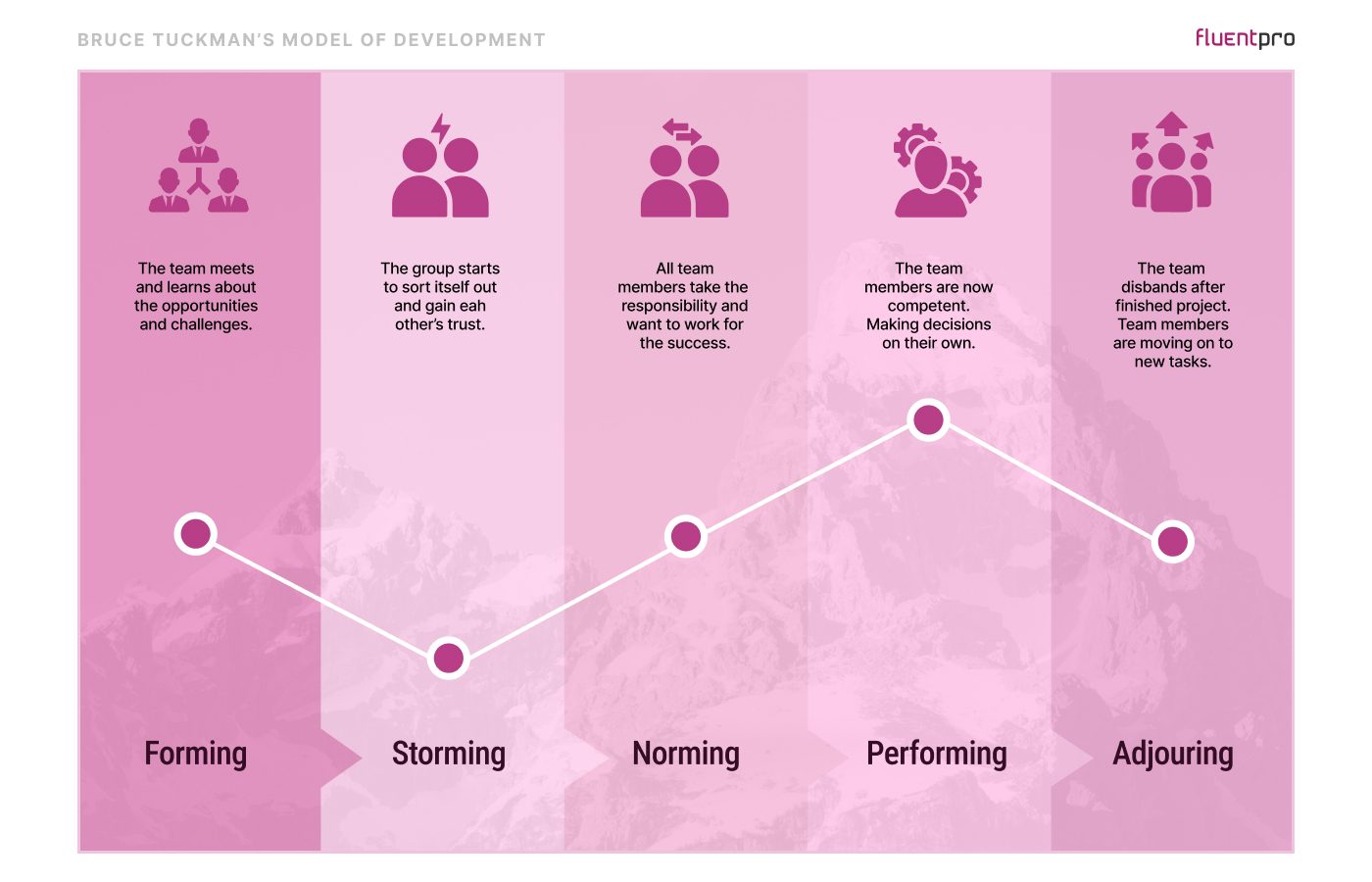
Peter Taylor
VP Global PMO
Keynote speaker and coach Peter is the author of the number 1 bestselling project management book ‘The Lazy Project Manager’, along with many other books.
He has built and led some of the largest PMOs in the world with organizations such as Siemens, IBM, UKG, and now Dayforce, where he is the VP Global PMO.
He has also delivered over 500 lectures worldwide in 26 countries and has been described as ‘perhaps the most entertaining and inspiring speaker in the project management world today’.
Effective leadership in project management
Long ago, Bruce Tuckman (an American psychological researcher) defined the stages of effective team dynamics as “forming, storming, norming and performing” (later on, “mourning” was added, recognizing project teams disband quickly and move on to other teams).
These continue to work well in the team formation and dynamics space, and I believe they are wholly relevant to today’s teams (as they were back in the 1960s when Tuckman first formulated his model). At least it does with some slight adaptation for the world of the project-based economy we now work within.
The Original Fantastic Four
The original model of effective team dynamics, famously outlined by Tuckman, comprises four key stages:
-
Forming
This is the beginning of a team formation and typically gathers varied resources from across an organization that may or may not have worked together. It is unlikely for a complete team to have done this. Therefore, the natural operating mode is to act independently due to the absence of established guidelines.
Any leader should focus on team building from introductions to skill set sharing, the alignment of purpose and goals, and the essential clarification of responsibilities.
As the new team members begin to engage with one another, the regular reinforcement of these goals helps to build and strengthen connections and, therefore, the working practices.
-
Storming
Then comes the sometimes rough “storming phase” where the team begins to work together but typically in a still individual manner or mindset. This can often lead to conflict as team members navigate their differences and find their place. During this transition period, personality clashes may occur.
However, this stage cannot be bypassed as it is crucial for fostering trust between the individuals as they learn to collaborate effectively.
-
Norming
The storming phase will pass, and a good leader will attempt to accelerate this phase as quickly as possible.
Once it does, and any disagreements are resolved, team cohesion will grow as team members accept each other’s personalities and their (different) working styles.
Now, in the norming phase, everyone begins to take collective responsibility for the goals and objectives that the team was created for, its very purpose, and slowly, mutual respect and cooperation become the ‘norm’.
-
Performing
Finally, with the team fully formed and running with well-established roles and standards, the project team now operates with high trust and strong collaboration. In such a state, teams often achieve remarkable success, especially towards the end of the project lifecycle, as all members are driven to achieve great success.
All team members become interdependently competent and autonomous, capable of making decisions without supervision but with a collective focus on the team objectives and goals.
The Famous Five
Tuckman later introduced a fifth stage: Adjourning (sometimes called “Mourning”). It reflects the feelings of loss that can occur when a high-performing team disbands after an impactful delivery to their organization. There may be a sense of something great ending, and the following work challenge may not yet be clear to team members as they go their separate ways back into the business.
I have found that many teams, including some I have led, continue to reconnect over coffee or calls or WhatsApp groups to maintain those fond memories of success and the resulting valuable relationships.
Life Beyond the Temporary
Teams that endure may enter a Transforming phase, where they can achieve significant performance through synergy. This stage goes beyond transactional leadership and can drive considerable change success in complex project/program situations.
Leaders aiming for such a high-performance level should embrace the natural progression of the resulting team dynamics by adopting a trusting and hands-off style. That is, letting the mature team get on with it and observing and engaging by exception.
The Essential Sixth Sense
Disrupting
Based on this commonly observed phenomenon, I will boldly declare yet another stage to the famous Tuckman model. It is not a sequential stage but a stage that overlays and impacts the first four (original) phases of teamwork and performance levels. It is mainly seen in the ‘Norming’ and ‘Performing’ stages. It is most impactful in the ‘Performing’ phase due to potential team dynamics and performance level disruption.
Hence, ‘Disrupting’ overlays the initial four stages rather than follows a linear progression. Recognizing this stage allows teams to navigate potential challenges that could derail their success.
This phase was first proposed in my book ‘Team Analytics: The Future of High-Performance Teams and Project Success’ (Routledge).
By understanding and addressing all these phases—including the potential for disruption—teams can enhance their collaborative effectiveness and overall performance.
However, such project-based teams require a strong leadership style in management (the ability to guide, inspire, and influence disparate people to work together to achieve a common goal). There are many examples of effective team dynamics based on my experience, and I am sure you also have your own.
Why project teams are simply different from other teams

Let’s consider the world of the temporary endeavor, the world of change delivery, where teams get together to align to a common goal but do not become a permanent community.
This requires certain leadership qualities in project management that understand the project world and appreciate the key differences in the team dynamics of projects.
Leadership is the ability of an individual (typically one person in the project world) to influence and guide team members to a common purpose.
The definition of team dynamics is the behavioral, psychological, and social interactions among a collection of team members and the overall cohesion within the project team or group.
And that is the key difference.
#1 Not 100%
A project team will likely incorporate members not 100% dedicated to the project. Instead, they will be part-time contributors (and not always voluntary ones) who, in parallel to the project work, must maintain their own ‘business as usual’ and keep supporting their full-time/permanent team colleagues.
#2 Never together
The second difference is that project teams are never all gathered on day one, and you must keep them for the project’s duration. At least, that has never happened in my experience – it probably does on some exceptional basis, but it is not the norm. The reason is simply economics; businesses cannot afford to dedicate valuable resources this way or backfill ‘lost’ team members while working on a project. Instead, team members come and go, appearing when they are specifically needed – or their skills are – and disappearing as soon as that work is completed.
#3 Culture clash
Difference number 3 brings us into the world of internal and external teams trying to find a way to work together rapidly. Again, cost is typically the reason here.
Start using a resource (especially an expensive external resource), and the budget starts getting burned up. Burn too much on just ‘getting to know each other’ and bang, your project is overrunning on expenditure, you are already in trouble as a project manager, and the project has barely even started.
If you think about it, internal teams have one thing in common – the culture of the organization they work for. External resources will bring their culture, expectations, biases, etc. It all adds to the mix of potential ‘storming’ igniting elements.
#4 Different objectives
And finally, difference number 4, objectives, or rather, varying objectives that might not align with your project goals and expected outcomes.
You can hardly expect anyone to join a high-performing team without having some impact – which could range from minimal to significant.
All these differences will have a disruptive impact on the project team dynamics.
The project manager cannot build their team once and guide them (without excessive intervention) through the storming to norming stages before the team naturally progresses to ‘performing’. This is impossible because resources are constantly joining and leaving the project. It is all part of the resource plan to balance having the right people with the right skills in place at the right time and not wasting people’s time or the cost associated with their time.
Tuckman does recognize this but doesn’t specifically consider this as significant as I do.
Even the most high-performing teams will revert to earlier stages in certain circumstances. Many long-standing teams go through these cycles as they react to changing circumstances. For example, a change in leadership may cause the team to revert to storming as the new people challenge the existing norms and dynamics of the team.
Disruptive Impact on Team Dynamics
All these factors can significantly disrupt project team dynamics. A project manager can’t simply build a stable team and expect it to navigate smoothly through the stages of development. The constant influx and departure of resources complicate this process, making it essential to balance having the right people with the right skills at the right time without wasting time or money.
Effective leadership strategies are crucial for managing these dynamics. Even the most high-performing teams can regress to earlier stages under certain circumstances. Established teams may go through development cycles repeatedly in response to changing conditions. For example, a leadership change can trigger a return to the storming phase as new members challenge existing norms and dynamics.
Therefore, the importance of effective leadership strategies in project management is evident, and the most essential aspect is understanding the different worlds of project teams.
While the Tuckman model remains true, we all must consider the ‘Disrupting’ effect in leading and managing project teams.
Protect your data
by downloading the comprehensive guide for project managers

























